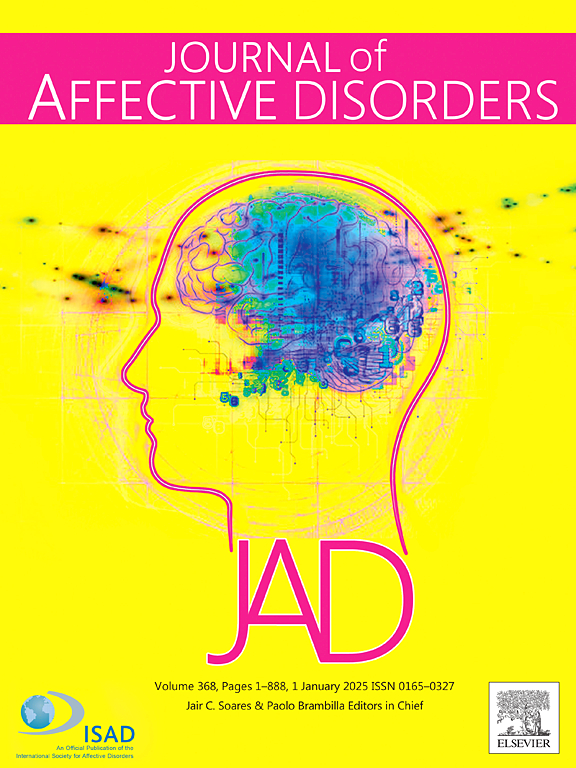经颅直流电刺激(tDCS)应用于左眶额皮质后改善情绪障碍患者的决策:一项概念验证研究。
IF 4.9
2区 医学
Q1 CLINICAL NEUROLOGY
引用次数: 0
摘要
决策缺陷存在于几种精神障碍中,包括神经性厌食症、成瘾、情绪障碍和自杀行为。改善决策是减少脆弱性和危险行为的相关治疗目标。经颅直流电刺激(tDCS)是一种简单且无创的技术,可以刺激感兴趣的皮质区域。先前的研究表明,健康志愿者的眼窝前额皮质(OFC)的tDCS在短期内改善了决策。我们的目标是在患有情绪障碍的患者中证明这种短期效果。这是一项前瞻性、单中心、干预性、随机对照试验(ClinicalTrial.govNCT06110559),采用单盲设计,有两个平行组(主动刺激和假刺激)。tDCS在左OFC(阳极Fp1/阴极Fp2)上应用30 min。主要结果是在刺激前后立即测量的爱荷华赌博任务(IGT)净得分的变化。62例患者随机接受积极刺激(N = 30)或假刺激(N = 32)。我们观察到活动组与假组IGT净评分有显著改善(时间*组相互作用χ2 = 4.10;p = .043)。其他认知任务(d2, Go/No-Go, Emotional Stroop)或自评感知情绪问卷(PANAS, STAI-Y-A)未发现显著变化。患者没有正确猜测治疗组。这些初步发现支持使用tDCS而不是OFC来改善情绪障碍患者的决策。未来的研究应该评估持续改进的最佳策略,以及在现实生活中的决策和功能方面的自然后果。本文章由计算机程序翻译,如有差异,请以英文原文为准。
Improved decision-making in patients with mood disorders following Transcranial Direct Current Stimulation (tDCS) applied to the left orbitofrontal cortex: A proof-of-concept study
Deficits in decision-making is found in several mental disorders, including anorexia nervosa, addiction, mood disorders, and suicidal behavior. Improving decision-making is a relevant therapeutic objective to reduce vulnerability and risky behaviors. Transcranial Direct Current Stimulation (tDCS) is a simple and non-invasive technique that allows for the stimulation of a cortical area of interest. Previous studies have shown that tDCS of the orbitofrontal cortex (OFC) in healthy volunteers improves decision-making in the short-term. We aimed to demonstrate this short-term effect in patients with a mood disorder. This was a prospective, single-center, interventional, randomized controlled trial (ClinicalTrial.gov NCT06110559) with two parallel arms (active vs sham stimulation) in a single-blind design. tDCS was applied during 30 min over the left OFC (anode Fp1/cathode Fp2). The primary outcome was a change in the net score on the Iowa Gambling Task (IGT) measured immediately before and after stimulation. Sixty-two patients were randomized to receive active (N = 30) or sham (N = 32) stimulation. We observed a significant improvement in IGT net score in the active vs sham arm (time*arm interaction χ2 = 4.10; p = .043). No significant change at other cognitive tasks (d2, Go/No-Go, Emotional Stroop) or self-rating perceived emotion questionnaires (PANAS, STAI-Y-A) was found. Patients did not correctly guess the treatment arm. These preliminary findings support the use of tDCS over the OFC to improve decision-making in patients with mood disorders. Future studies should assess the best strategies for sustained improvement, and the naturalistic consequences in terms of real-life decision-making and functioning.
求助全文
通过发布文献求助,成功后即可免费获取论文全文。
去求助
来源期刊

Journal of affective disorders
医学-精神病学
CiteScore
10.90
自引率
6.10%
发文量
1319
审稿时长
9.3 weeks
期刊介绍:
The Journal of Affective Disorders publishes papers concerned with affective disorders in the widest sense: depression, mania, mood spectrum, emotions and personality, anxiety and stress. It is interdisciplinary and aims to bring together different approaches for a diverse readership. Top quality papers will be accepted dealing with any aspect of affective disorders, including neuroimaging, cognitive neurosciences, genetics, molecular biology, experimental and clinical neurosciences, pharmacology, neuroimmunoendocrinology, intervention and treatment trials.
 求助内容:
求助内容: 应助结果提醒方式:
应助结果提醒方式:


